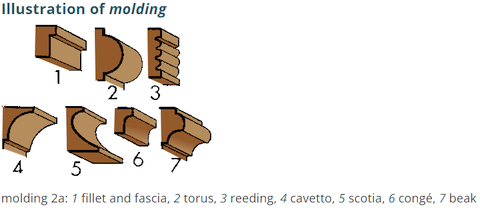coin
A coin is a small, flat, (usually, depending on the country or value) round piece of metal or plastic used primarily as a medium of exchange or legal tender. They are standardized in weight, and produced in large quantities at a mint [铸币厂] in order to facilitate trade. They are most often issued by a government. Coins often have images, numerals, or text on them. Obverse [正面; 前面; 主要的一面] and its opposite, reverse, refer to the two flat faces of coins and medals. In this usage, obverse means the front face of the object and reverse means the back face. The obverse of a coin is commonly called heads, because it often depicts the head of a prominent person, and the reverse tails.
Coins are usually metal or an alloy, or sometimes made of manmade materials. They are usually disc shaped. Coins made of valuable metal are stored in large quantities as bullion [gold or silver, usually in the form of bars] coins. Other coins are used as money in everyday transactions, circulating alongside banknotes. Usually the highest value coin in circulation (excluding bullion coins) is worth less than the lowest-value note. In the last hundred years, the face value of circulation coins has occasionally been lower than the value of the metal they contain, for example due to inflation. If the difference becomes significant, the issuing authority may decide to withdraw these coins from circulation, possibly issuing new equivalents with a different composition, or the public may decide to melt the coins down or hoard [积存] them.
In China, early round coins appeared in the 4th century BCE and were adopted for all China by Emperor Qin Shi Huang Di at the end of 3rd century BCE. The round coin, the precursor of the familiar cash coin, circulated in both the spade and knife money areas in the Zhou period, from around 350 BCE. Apart from two small and presumably late coins from the State of Qin, coins from the spade money area have a round hole and refer to the jin and liang units. Those from the knife money area have a square hole and are denominated in hua (化).
秦朝以后两千多年间的钱币,除王莽一度行刀币外,中间都有一方孔,故称钱为“方孔钱”,也被戏称为“孔方兄”;“孔方兄”的出处为西晋鲁褒著《钱神论》以讽时弊,拟钱为长兄,字曰“孔方”。方孔钱是由圜钱演变而来的,以秦朝的“半两钱”为最早,中华民国时期的“民国通宝”为最晚。半两钱为圆形方孔,重12铢(1两=24铢)。圜钱也称圜金、环钱,是一种中国古代铜币。主要流通于战国时的秦国和魏国。圆形,中央有一个圆孔。钱上铸有文字。一说由纺轮演变而来;一说由璧环演变而来。是方孔钱的前身。
刀币”正式称谓是“刀化(货)刀币”。东方的齐国和北方的燕国主要使用刀币。刀币分“燕明刀”和“齐刀化”二大类型。刀币形状取象于山戎、北狄等北方游牧民族渔猎用的刀类工具。由于齐刀面有“化”字文而称“刀化”。目前已经发现并著录的齐刀有“齐法化”、“齐之法化”、“安阳之法化”、“节墨之法化”、“簟邦法化”、“齐建(造)邦长法化”等数种。其中“节墨”、“安阳”、“齐”均为地名,“节墨”即今山东即墨,“安阳”即今山东曹县一带,“齐”指齐国都城临淄。zdic.net说货是化的异体字。也许化+贝(壳)=货物交换。
铜钱是熔化金属在模子里铸成的。因此它的边缘会出现多余金属而不整齐,需要打磨。工匠将多枚铜钱用棍串起来打磨。如果中间的孔是圆的,打磨起来铜钱容易转动。板板六十四形容不知变通或不能通融。板:即“版”,铸钱的模子。出自清·范寅《越谚·数目之谚》:板板六十四,铸钱定例也,喻不活。”
If you coin a word or a phrase, you are the first person to say it. 不过浇铸/铸件是cast. 铅字/活字: type. (int)(3.14 + 0.5)叫typecast。把浮点数化为二进制位再铸为integer. C++里可写作int(3.14 + 0.5),像调用int类的构造函数。
Circulating coins commonly suffered from "shaving" or "clipping": the public would cut off small amounts of precious metal from their edges to sell it and then pass on the mutilated coins at full value. Unmilled British sterling silver coins were sometimes reduced to almost half their minted weight. This form of debasement [the action of reducing the value or quality of sth] in Tudor [都铎duó] England was commented on by Sir Thomas Gresham, whose name was later attached to Gresham's law. The monarch would have to periodically recall circulating coins, paying only the bullion value of the silver, and reminting them. This, also known as recoinage, is a long and difficult process that was done only occasionally. Many coins have milled or reeded edges, originally designed to make it easier to detect clipping.
mill
LDOCE
press, roll, or shape metal in a machine
牛津
produce regular markings on the edge of (a coin) 在(硬币)上轧花边
cut or shape (metal) with a rotating tool 铣(金属)
Mill Definition & Meaning - Merriam-Webster
铣【汉典】n. xiǎn; v. xǐ. 词性不同发音不同,如record,汉语也有。
In numismatics [钱币学], the term milled coinage (also known as machine-struck coinage) is used to describe coins which are produced by some form of machine, rather than by manually hammering coin blanks between two dies (hammered coinage) or casting coins from dies. Until 1550, coinage techniques used in European mints had not progressed from the hammered coinage of Ancient Greece. This was problematic because an increase in the supply of bullion from central Europe and America was overworking mints. That led to low quality coins which were easily forged or clipped, i.e. precious metal was shaved from the edges of the coins. In accordance with Gresham's law, the clipped and forged coins drove good coins out of circulation, depreciating the currency.
In 1662 Charles II recalled Blondeau to establish a permanent machine made coinage. He employed a secret process for placing lettering or other designs on the edges of coins. The inscription chosen for the edge - DECVS ET TVTAMEN, meaning an ornament and a safeguard - refers to the protection against clipping which the lettered edge provided.
In modern practice in the United States, milling, or a milled edge, can refer to the raised edge on the coin face, applied by a special milling machine after the planchets [metal disk to be stamped as a coin] are cut out and polished. In addition, the reeding [a small convex molding] of coins of higher value, applied by the collar holding the coin when it is stamped, can be considered part of the milled edge.

Fiat money first arose in medieval China, with the jiaozi [交子] paper money. Fiat money is any money that is accepted by a government for paying taxes or debt, but is not pegged to or backed directly by gold and other valuables (fiat money systems have no gold standard).
六级/考研单词: medium, illicit, tender, mint, seldom, issue, reverse, medal, usage, depict, prominent, alloy, silver, circulate, banknote, inflate, differentiate, equivalent, compose, melt, emperor, spade, presume, shave, clip, precious, comment, sovereign, mill, detect, regulate, rotate, manual, hammer, forge, accordance, depreciate, perpetual, ornament, safeguard, unite, polish, collar, medieval, peg




 浙公网安备 33010602011771号
浙公网安备 33010602011771号